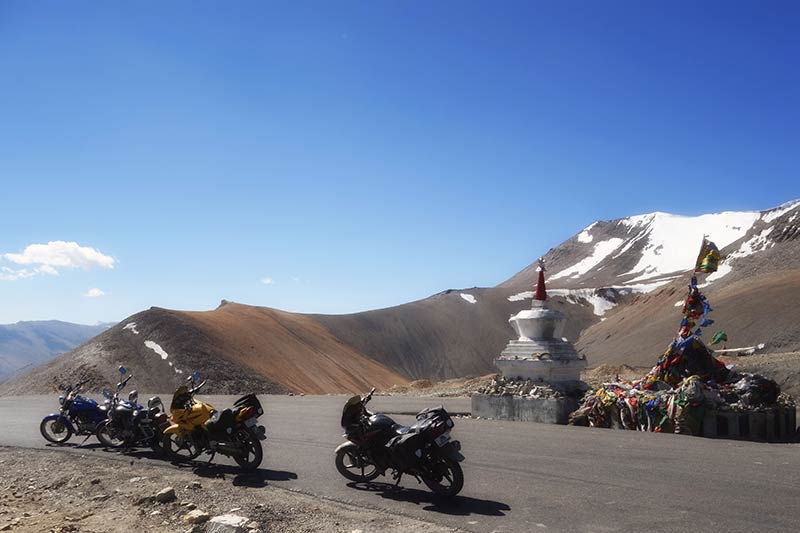Riding motorcycles in Ladakh
Apologies in advance for the video-embed-heavy post.
Our stay in Ladakh has been the longest in any single place on this trip thus far, and for good reason. It's a stunningly beautiful region with high, austere mountains, big skies, and water that really is turquoise blue even on a cloudy day. All of that combined with more and more well-paved roads makes for the best riding (or driving) of my life.
Zoji-la: crossing from Kashmir to Ladakh
Zoji-la is the pass between Srinagar and Kargil that separates Kashmir from Ladakh. On the ascent, everything is green and forested and dotted with waterfalls. On the other side, the vegetation mostly disappears from the hillsides, and the mountains transition from green to multi-hued rock. It gets even drier as you leave Kargil and cross a few more high mountain passes.
Ascent to Zoji-la, Kashmiri side:
After Zoji-la, the Ladakhi side
As always, though, be careful of the [sheep/cows/goats/horses/water buffalo] in the road.
Zanskar Valley
Our first major off-route excursion, Zanskar, was not included in the "beautiful pavement" category — the riding was bone-joltingly bumpy and had us spending most of our time weaving across the road, trying to choose the least jarring path for the bike wheels.
It still made for some amazing scenery though, at least when we were able to look up from the road. Some pretty memorable experiences, too. After leaving behind the motorcycles, we hitched a ride with a jeep driver who introduced us to a group of cow and yak herders, and got us some fresh yogurt.
Lakes and Rivers
Inevitably, staying at a place like SECMOL means you meet some pretty awesome people (more on that later). A few other volunteers there were also interested in a little exploring by motorbike, so we planned a weekend trip together to see a few of Ladakh's famously beautiful saltwater lakes. Pangong Tso, the most famous lake, has reportedly become a little touristy since I last visited in 2011, so we chose to go to Tso Moriri instead, stopping by Tso Kar and Kiagar Tso on the way (tso = lake in Ladakhi).
Since every group of bike riders clearly needs a good name, let me introduce the Warm Milk Gang (hey, it's a surprisingly satisfying drink after a long day of frozen hands and below-zero windchill). I fully expect this group to re-form and go on new adventures, especially when a couple more people learn to ride (looking at you, Zorawer and Meriya).
The above clip is us arriving at the top of Taglang La, the second highest motorable road at 17,582ft. It's an amazing experience to ride at that altitude, and both you and your bike feel it. You notice the loss of engine power on accelerations and steep uphills, and even in August wearing heavy winter biking gloves, your hands definitely feel the drop in temperature.

Tso Kar
Riding up to Tso Kar feels a little otherworldly with its salt marshes and dry purple-hued mountains. It was deserted when we arrived, and continued that way the entire time we were there. Karan found a road up to the water while the rest of us hopped around on clumps of grass sticking out of the marsh, and we were able to ride almost all the way up to the crackly, salty shore.
Kiagar Tso and the Indus River
Oddly enough, the least well-known lake was my favorite from the trip. Kiagar Tso is a tiny blue gem set in a ring of snow-capped mountains. We rode up as the sun was sinking low in the sky, throwing dramatic shadows and making the lake almost glow (video here). I completely failed to do it justice with either photos or video.
Other highlights include a beautiful stretch of road along the Indus, eating instant noodles and tea in a tent along the route, napping across from some yaks, and of course the warm milk.
In the end, the main, overwhelming feeling of riding in Ladakh is one of being very, very small in a vast world. Mountains tower over you, valleys sweep out to either side, and the human footprint is relatively small compared to the enormity of the landscape. The effect is humbling, awe-inspiring, and breathtaking — sometimes literally.